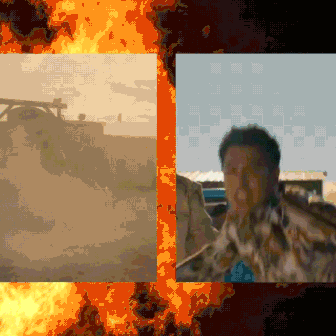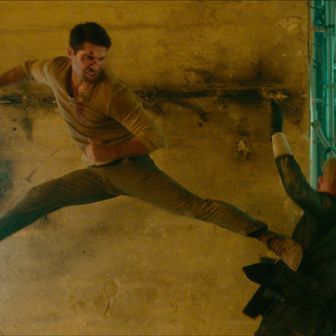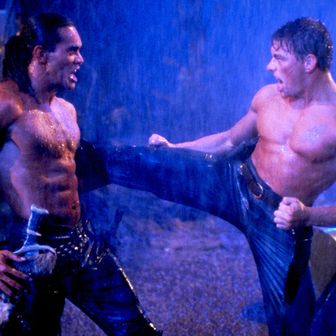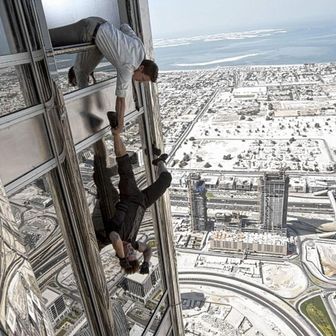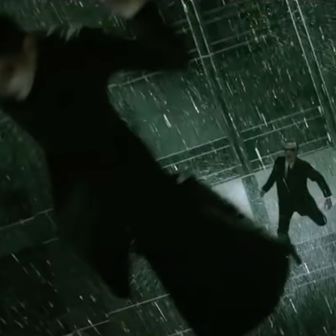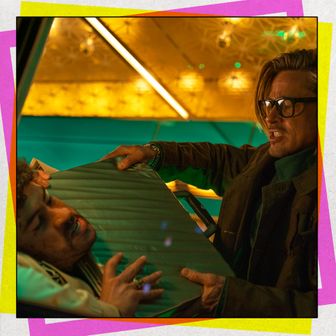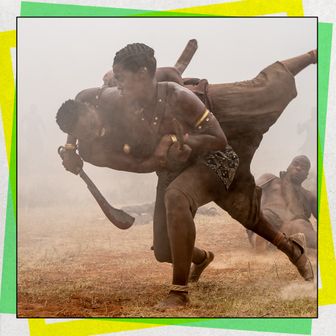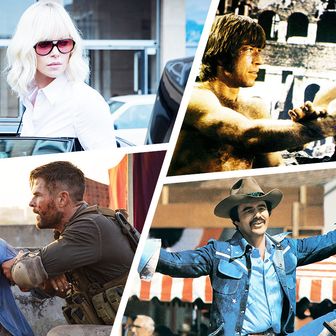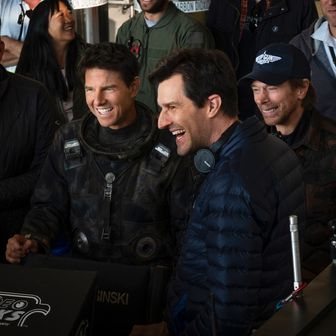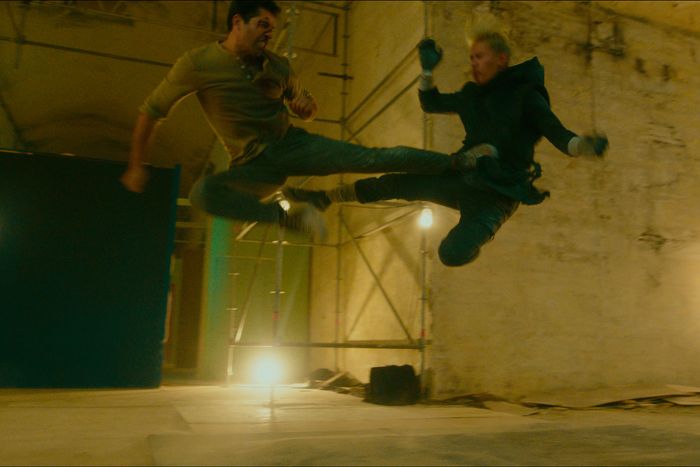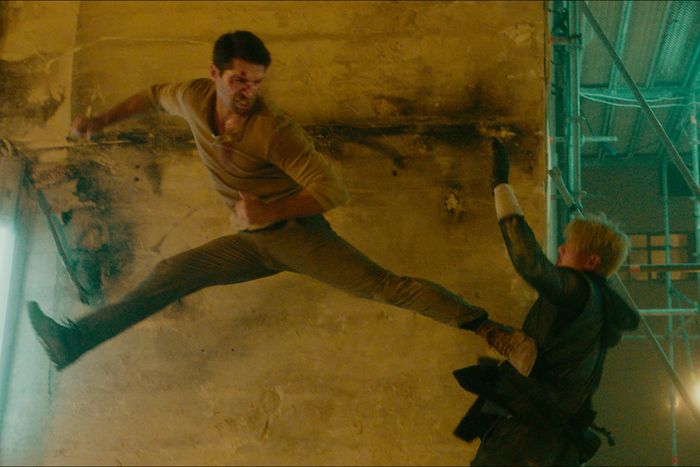
Accident Man: Hitman’s Holiday is a recipient of Vulture’s first ever Stunt Award: Best Fight. Read about the winners of the inaugural celebration of stunt professionals here.
In Accident Man: Hitman’s Holiday, assassin Mike Fallon is just trying to get away. His days of meticulously murdering the dredges of London and staging their deaths to appear as inconspicuous little mishaps are behind him, and he’s starting a new life and career in balmy Malta. Or, at least, that’s what the title to the breakneck comedy sequel — the rejoinder to 2018’s Accident Man, starring English filmmaker, actor, and martial artist Scott Adkins — suggests. Of course, the heat followed Mike, and the story that unfolds (co-written by Adkins and based on the comic books he grew up reading) plays like a giant game of cats and mouse. Mike battles baddies who want to end him in a series of duels that build up to a thrillingly technical third-act face-off between Mike and the film’s “bona fide fucking ninja” Oyumi, played by stuntman, martial artist, and fight choreographer Andy Long.
Adkins, who has appeared in action blockbusters such as The Bourne Ultimatum and X-Men Origins: Wolverine and will fight alongside Keanu Reeves in John Wick 4, is best known for his relentless, hybrid combat style in direct-to-video and limited-release gems like the Undisputed and Accident Man franchises. He describes Mike and Oyumi’s fight in Hitman’s Holiday as a partnership — not a meeting of enemies or foes but “a violent dance” that requires two people who trust each other completely. Adkins and Long boast decades of experience between them (Adkins practices a combination of karate, Krav Maga, jujutsu, capoeira, ninjutsu, wushu, aikido, MMA, and gymnastics, while Long specializes in kung fu, Tae Kwon Do, judo, hapkido, and Wing Chun), and they’ve collaborated onscreen before in Boyka: Undisputed and The Intergalactic Adventures of Max Cloud. It all amounts to a crucial sense of ease between them, which Adkins says allows them to take their choreographed dance from a practiced 80 percent speed to a jaw-dropping 100 percent on set.
But are Adkins and Long somehow moving faster than 100 percent speed in this scene? Co-directors Harry and George Kirby (self-described “big anime geeks”) wanted to go “almost cartoony with the action, as over the top as possible,” Harry says. The choreography Adkins and Long came up with walks the line between immersive and unbelievable, the four-minute sequence inspired by the rhythms and cinematography of Hong Kong action cinema (Adkins started his career in Jackie Chan films, and Long was a member of the Jackie Chan Stunt Team). Dozens of camera angles track the pair’s whirling bodies as they punch, parry, and kick. The sparseness of the production design and cleanness of the editing permit Adkins and Long’s full-tilt gracefulness to be the scene’s primary focus. There are no unnecessary frills, no extraneous beats. Accident Man: Hitman’s Holiday simply “fills the frame with glorious action,” as Adkins puts it, an accomplishment that was harder to pull off than it sounds.
.
Choose your acrobatic kicks carefully.
With only 23 days to shoot Accident Man: Hitman’s Holiday, extensive preproduction was a necessity. Director of photography Richard Bell started designing a 360-degree lighting setup that could illuminate every corner of the abandoned underground hideout where the final fight would take place, and Long began putting together a rough structure of the choreography. He and Adkins spent two days finalizing the movements in the conference room of a hotel in Malta, paying particular attention to the scene’s acrobatic kicks — “When you fight the man who has done all possible kick variations in his career,” Long points out, finding new ones is particularly challenging.
They practiced the scene in the hotel’s squash court, where Long dragged his own tripod to map the shots they’d eventually use, a combination of wide perspectives that allow the audience to see all the action at once and a few tight close-ups to punctuate the beats of the fight. In the style of Hong Kong action, each angle is preconceived rather than discovered through the process of editing (as is more common in western action). “That’s what makes it feel energetic and pace-y and keeps you interested,” George explains.
George — also a stunt performer and fight coordinator on films including The Batman, Venom: Let There Be Carnage, and Doctor Strange (with Adkins) — joined the fighters, along with Hitman’s Holiday stunt coordinator Morgan Chetcuti, for one more day of pre-visualization, working out a blueprint for the slightest of camera tilts. That plan would be distributed to all departments from cinematography to makeup and costume. “It’s like a jigsaw puzzle,” says Adkins, “and we know where the pieces will go.”
.
Commit to the violent dance.
The fight begins with grandiosity: Mike, in his signature leather jacket, and Oyumi, decked in an all-black ninja-yoroi outfit, sprint and leap toward each other from opposite sides of the set — which in reality was the Marsa Power Station in Malta, which Harry describes as a “weirdly oppressive” cave. Oyumi is on the offensive, landing punches and kicks with Mike always a half-second behind him. When Oyumi seemingly defeats Mike by ripping off the jacket, temporarily wielding it like a weapon and then insultingly putting it on himself, Long delivers a sneering proclamation: “loser.” (It’s an “Arnie thing,” Harry explains, referring to Arnold Schwarzenegger’s penchant for braggadocious taglines. An alternate version of a later moment in the scene even had Long saying “Auf wiedersehen.”)
That moment sets off Mike’s comeback. He overwhelms Oyumi with a run and jump off a wall, a backward spin, and a sidekick. The camera tracks the entire sequence. “The beauty of this was we’ve got two performers who can do it all and do it very well,” George notes. “You can just hold the frame, keep them in, see their faces, and see them doing everything.” Adkins and Long had so perfected the routine they’d even committed the timing of every grunt, exhale, and kiai exclamation to memory. “They were able to step into the ADR booth and pretty much straight off the bat just make the sounds in the right places,” Harry adds. “It was so crazy to watch.”
To a casual viewer, the jacket sequence might seem like the most difficult bit of the fight. The move was a collaboration between Adkins, who admittedly wanted the confining jacket to come off at some point during the scene, and Long, who naturally leans toward “Jackie Chan trickery” (the gag is reminiscent of Chan moves in Police Story 4: First Strike and The Accidental Spy). But they both attest it was more straightforward to pull off than it looks. Like almost every other sequence within the scene, they needed only two to three attempts to nail the take. (“When you work with someone who’s not as experienced, you can end up doing ten, 15, 20,” Adkins says.)
Still, the scene wasn’t without some setbacks. On the second day of filming, Adkins injured his left knee while (of all things) skipping during a warm-up and forced himself to fight through the pain. Later, some footage of an overhead shot of Adkins and Long trading punches was deemed unusable, so they had to return to the power station to recreate the blows. And despite everyone’s best efforts, some barely perceptible errors made their way into the finished product, like when Adkins is seen rolling one way after getting hit in the face and then spins in the opposite direction in the accompanying close-up. Did you catch that split-second glimpse of a COVID-mask-wearing crew member standing at the edge of the frame and watching the fight? The Kirby brothers bet the answer is “no”: The action is so consuming, neither blip affects the integrity of the showdown.
.
Master the art of losing.
The more difficult part of the fight, the performers agree, is selling their own defeat. “You know, you’re gonna kick the crap out of me,” Adkins recalls telling Long to entice him into taking the part of Oyumi in the film. “And that’s okay with me.” There’s a skill to beating people up, but there’s also another skill to getting beaten up and selling other people’s hits, he explains. “It’s probably harder. Not everyone can do it.”
Adkins and Long learned how to lose in the style of Jackie Chan. Young Adkins was often cast as the guy who would run into a scene from the left and get hit by the hero, and Long relishes the experience Adkins brings to the scene. “The better your partner can sell his or her reaction, the better your own moves will look onscreen,” says Long. Indeed, he begins the scene with the upper hand, gleefully taunting Mike with his middle finger and a snarky request to “keep up.” But he eventually cedes ground to Mike, who learns to evade Oyumi’s jabs, eventually landing a kick on his torso and slamming him into the ground. Long had to sell that shock, persuading the audience to believe he didn’t see it coming.
Fight performances are really about multitasking: tapping into the muscle memory needed to retain choreography and blocking cues while spontaneously deploying the expressiveness that seals the illusion for the audience — so much so that we believe when Mike’s father figure, Big Ray, appears at exactly the right moment to prompt a blood-bag explosion on Oyumi and save the Accident Man with one fatal shot.
More From This Series
- And the Winners of the 2024 Stunt Awards Are …
- The Second Annual Stunt Awards Are Here
- Academy Awards Reportedly in Preliminary Talks for a Stunt Category


